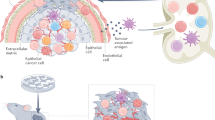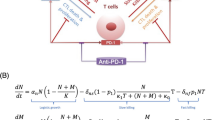Abstract
TGF-β is an immunoregulatory protein that contributes to inadequate antitumor immune responses in cancer patients. Recent experimental data suggests that TGF-β inhibition alone, provides few clinical benefits, yet it can significantly amplify the anti-tumor immune response when combined with a tumor vaccine. We develop a mathematical model in order to gain insight into the cooperative interaction between anti-TGF-β and vaccine treatments. The mathematical model follows the dynamics of the tumor size, TGF-β concentration, activated cytotoxic effector cells, and regulatory T cells. Using numerical simulations and stability analysis, we study the following scenarios: a control case of no treatment, anti-TGF-β treatment, vaccine treatment, and combined anti-TGF-β vaccine treatments. We show that our model is capable of capturing the observed experimental results, and hence can be potentially used in designing future experiments involving this approach to immunotherapy.








Similar content being viewed by others
References
Akhurst, R., & Derynck, R. (2001). TGF-β signaling in cancer—a double-edged sword. Trends Cell Biol., 11(11), S44–S51.
Baylor College of Medicine. (2006). Safety study of injections of autologous/allogeneic TGFBeta-resistant LMP2A-specific cytotoxic T lymphocytes (CTL). Bethesda: National Library of Medicine. Available from http://clinicaltrials.gov/ct/show/NCT00368082.
Baylor College of Medicine. (2009). Her2 and TGFBeta in treatment of Her2 positive lung malignancy (HERCREEM). Bethesda: National Library of Medicine. Available from http://clinicaltrials.gov/ct/show/NCT00368082.
Beyer, M., & Schultze, J. L. (2006). Regulatory T cells in cancer. Blood, 108(3), 804–811.
Blattman, J. N., & Greenberg, P. D. (2004). Cancer immunotherapy: a treatment for the masses. Science, 305(5681), 200–205.
Blattman, J. N., Antia, R., Sourdive, D. J. D., Wang, X., Kaech, S. M., Murali-Krishna, K., Altman, J. D., & Ahmed, R. (2002). Estimating the precursor frequency of naive antigen-specific CD8 T cells. J. Exp. Med., 195(5), 657–664.
Byrne, H., & Gourley, S. (1997). The role of growth factors in avascular tumour growth. Math. Comput. Model., 26(4), 35–55.
Cappuccio, A., Elishmereni, M., & Agur, Z. (2006). Cancer immunotherapy by interleukin-21: potential treatment strategies evaluated in a mathematical model. Cancer Res., 66(14), 7293–7300.
Castiglione, F., & Piccoli, B. (2006). Optimal control in a model of dendritic cell transfection cancer immunotherapy. Bull. Math. Biol., 68(2), 255–274.
Cerwenka, A., & Swain, S. L. (1999). TGF-β1: immunosuppressant and viability factor for T lymphocytes. Microbes Infect., 1(15), 1291–1296.
Clarke, D. C., & Liu, X. (2008). Decoding the quantitative nature of TGF-beta/Smad signaling. Trends Cell Biol., 18(9), 430–442.
Currie, G. (1972). Eighty years of immunotherapy: a review of immunological methods used for the treatment of human cancer. Br. J. Cancer, 141–153.
de Pillis, L. G., Radunskaya, A., & Wiseman, C. L. (2005). A validated mathematical model of cell-mediated immune response to tumor growth. Cancer Res., 65(17), 7950–7958.
de Pillis, L. G., Gu, W., & Radunskaya, A. E. (2006). Mixed immunotherapy and chemotherapy of tumors: modeling, applications and biological interpretations. J. Theor. Biol., 238(4), 841–862.
Dermime, S., Armstrong, A., Hawkins, R. E., & Stern, P. L. (2002). Cancer vaccines and immunotherapy. Br. Med. Bull., 62, 149–162.
Derynck, R., Akhurst, R. J., & Balmain, A. (2001). TGF-β signaling in tumor suppression and cancer progression. Nat. Genet., 29(2), 117–129.
d’Onofrio, A. (2005). A general framework for modeling tumor-immune system competition and immunotherapy: mathematical analysis and biomedical inferences. Physica D, Nonlinear Phenom., 208(3–4), 220–235.
Eftimie, R., Bramson, J., & Earn, D. (2011). Interactions between the immune system and cancer: a brief review of non-spatial mathematical models. Bull. Math. Biol., 73, 2–32.
Flavell, R. A., Sanjabi, S., Wrzesinski, S. H., & Lixon-Limon, P. (2010). The polarization of immune cells in the tumour environment by TGFβ. Nat. Rev. Immunol., 10(8), 554–567.
Kim, P., Lee, P., & Levy, D. (2010). Emergent group dynamics governed by regulatory cells produce a robust primary t cell response. Bull. Math. Biol., 72, 611–644.
Kim, P. S., Lee, P. P., & Levy, D. (2007). Modeling regulation mechanisms in the immune system. J. Theor. Biol., 246(1), 33–69.
Kirschner, D., & Panetta, J. C. (1998). Modeling immunotherapy of the tumor-immune interaction. J. Math. Biol., 37(3), 235–252.
Kirschner, D., Jackson, T., & Arciero, J. (2003). A mathematical model of tumor-immune evasion and siRNA treatment. Discrete Contin. Dyn. Syst., Ser. B, 4(1), 39–58.
Kogan, Y., Forys, U., Shukron, O., Kronik, N., & Agur, Z. (2010). Cellular immunotherapy for high grade gliomas: mathematical analysis deriving efficacious infusion rates based on patient requirements. SIAM J. Appl. Math., 70(6), 1953–1976.
Kolev, M. (2005). A mathematical model for single cell cancer immune system dynamics. Math. Comput. Model., 41, 1083–1095.
Kuznetsov, V., Makalkin, I., Taylor, M., & Perelson, A. (1994). Nonlinear dynamics of immunogenic tumors: parameter estimation and global bifurcation analysis. Bull. Math. Biol.
Llopiz, D., Dotor, J., Casares, N., Bezunartea, J., Díaz-Valdés, N., Ruiz, M., Aranda, F., Berraondo, P., Prieto, J., Lasarte, J. J., Borrás-Cuesta, F., & Sarobe, P. (2009). Peptide inhibitors of transforming growth factor-β enhance the efficacy of antitumor immunotherapy. Int. J. Cancer, 125(11), 2614–2623.
Michelson, S., & Leith, J. (1991). Autocrine and paracrine growth factors in tumor growth: a mathematical model. Bull. Math. Biol., 53(4), 639–656.
Murphy, K., Travers, P., Walport, M., et al. (2008). Immunobiology. New York: Garland Science.
Paillard, F. (2000). Immunosuppression mediated by tumor cells: a challenge for immunotherapeutic approaches. Hum. Gene Ther., 11(5), 657–658.
Reiss, M. (1999). TGF-β and cancer. Microbes Infect., 1(15), 1327–1347.
Ribas, A., Butterfield, L. H., Glaspy, J. A., & Economou, J. S. (2003). Current developments in cancer vaccines and cellular immunotherapy. J. Clin. Oncol., 21(12), 2415–2432.
Ribba, B., Colin, T., & Schnell, S. (2006). A multiscale mathematical model of cancer, and its use in analyzing irradiation therapies. Theor. Biol. Med. Model., 3, 7.
Rosenberg, S. A. (2001). Progress in human tumour immunology and immunotherapy. Nature, 411(6835), 380–384.
Rosenberg, S. A., Yang, J. C., & Restifo, N. P. (2004). Cancer immunotherapy: moving beyond current vaccines. Nat. Med., 10(9), 909–915.
Sakaguchi, S., Yamaguchi, T., Nomura, T., & Ono, M. (2008). Regulatory T cells and immune tolerance. Cell, 133(5), 775–787.
Sakaguchi, S., Miyara, M., Costantino, C. M., & Hafler, D. A. (2010). FOXP3+ regulatory T cells in the human immune system. Nat. Rev. Immunol., 10(7), 490–500.
Terabe, M., Ambrosino, E., Takaku, S., O’Konek, J. J., Venzon, D., Lonning, S., McPherson, J. P., & Berzofsky, J. A. (2009). Synergistic enhancement of CD8+ T cell-mediated tumor vaccine efficacy by an anti-transforming growth factor-β monoclonal antibody. Clin. Cancer Res., 15(21), 6560–6569.
Wang, S. E., Hinow, P., Bryce, N., Weaver, A. M., Estrada, L., Arteaga, C. L., & Webb, G. F. (2009). A mathematical model quantifies proliferation and motility effects of TGF-β on cancer cells. Comput. Math. Methods Med., 10(1), 71–83.
Wilson, S. N., Lee, P., & Levy, D. (2010). A mathematical model of the primary T cell response with contraction governed by adaptive regulatory T cells. In K. E. Herold, W. E. Bentley, & J. Vossoughi (Eds.), Proceedings IFMBE (Vol. 32, pp. 209–212). Berlin: Springer.
Acknowledgements
The authors would like to thank Jim Greene for his helpful comments. This work was supported in part by the joint NSF/NIGMS program under Grant Number DMS-0758374 and in part by Grant Number R01CA130817 from the National Cancer Institute. The content is solely the responsibility of the authors and does not necessarily represent the official views of the National Cancer Institute or the National Institutes of Health.
Author information
Authors and Affiliations
Corresponding author
Rights and permissions
About this article
Cite this article
Wilson, S., Levy, D. A Mathematical Model of the Enhancement of Tumor Vaccine Efficacy by Immunotherapy. Bull Math Biol 74, 1485–1500 (2012). https://doi.org/10.1007/s11538-012-9722-4
Received:
Accepted:
Published:
Issue Date:
DOI: https://doi.org/10.1007/s11538-012-9722-4




